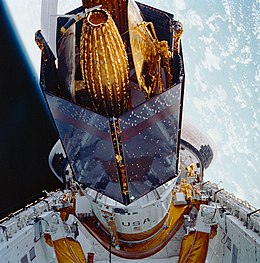TDRS-3, known before launch as TDRS-C, is an American communications satellite, of first generation, which is operated by NASA as part of the Tracking and Data Relay Satellite System. It was constructed by TRW, and is based on a custom satellite bus which was used for all seven first generation TDRS satellites.[4]
 TDRS-C aboard Discovery | |
| Mission type | Communication |
|---|---|
| Operator | NASA |
| COSPAR ID | 1988-091B |
| SATCAT no. | 19548 [1] |
| Mission duration | Planned: 10 years Elapsed: 36 years, 1 month, 23 days |
| Spacecraft properties | |
| Bus | TDRS |
| Manufacturer | TRW |
| Launch mass | 2,224.9 kg (4,905 lb)[2] |
| Dimensions | 17.3 × 14.2 m (57 × 47 ft)[2] |
| Power | 1700 watts[2] |
| Start of mission | |
| Launch date | 29 September 1988, 15:37:00 UTC |
| Rocket | Space Shuttle Discovery STS-26 / IUS |
| Launch site | Kennedy Space Center LC-39B |
| Contractor | Rockwell International |
| Orbital parameters | |
| Reference system | Geocentric orbit |
| Regime | Geostationary orbit |
| Longitude | 151° West (1988) 171° West (1988–1990) 174° West (1990–1991) 62° West (1991–1994) 171° West (1994–1995) 85° East (1995–2009) 49° West (2009–) |
| Epoch | 29 September 1988 [3] |
Launch
editThe TDRS-C satellite was launched aboard Space Shuttle Discovery during the STS-26 mission in 1988; the first Shuttle flight since the Challenger disaster which had resulted in the loss of the previous TDRS satellite, TDRS-B. Discovery launched from Launch Complex 39B at the Kennedy Space Center at 15:37:00 UTC on 29 September 1988.[5] TDRS-C was deployed from Discovery around six hours after launch, and was raised to geostationary orbit by means of an Inertial Upper Stage.[5]
Deployment
editThe two-stage solid-propellent Inertial Upper Stage made two burns. The first stage burn occurred shortly after deployment from Discovery, and placed the satellite into a geosynchronous transfer orbit. At 04:30 UTC on 30 September 1988, it reached apogee, and the second stage fired, placing TDRS-C into geosynchronous orbit. At this point it received its operational designation. Although the TDRS-2 designation had not been assigned, TDRS-C was given the designation TDRS-3 as NASA did not want to reuse the designation which had been intended for the STS-51-L payload.[6] It was briefly placed at a longitude 151° West of the Greenwich Meridian, before being moved to 171.0° West before the end of 1988, from where it provided communications services to spacecraft in Earth orbit, including Space Shuttles. In 1990, it was relocated to 174.0° West, and again in 1991 to 62.0° West. In 1994, it returned to 171.0° West.[7][8] In June 1995, it was moved to 85.0° East, from where it was used primarily for communications with spacecraft such as the Compton Gamma Ray Observatory and the Hubble Space Telescope.[7][9] In October 2009, as NASA began decommissioning TDRS-1, TDRS-3 was moved to 49.0° West,[10] where it remains in storage as of 2020.[11]
See also
editReferences
edit- ^ McDowell, Jonathan. "SATCAT". Jonathan's Space Pages. Retrieved 18 March 2014.
- ^ a b c "Tracking and Data Relay Satellite (TDRS) Characteristics". NASA. 10 September 2014. Retrieved 28 July 2020.
- ^ "NASA – NSSDCA – Spacecraft – Trajectory Details". nssdc.gsfc.nasa.gov. Retrieved 2 May 2018. This article incorporates text from this source, which is in the public domain.
- ^ Krebs, Gunter. "TDRS 1, 2, 3, 4, 5, 6". Gunter's Space Page. Retrieved 8 August 2009.
- ^ a b McDowell, Jonathan. "Launch Log". Jonathan's Space Page. Retrieved 8 August 2009.
- ^ "Designation". NASA'S Tracking and Data Relay Satellite. NASA. December 1992. Archived from the original on 3 August 2009. This article incorporates text from this source, which is in the public domain.
- ^ a b "TDRS 3". TSE. Retrieved 8 August 2009.
- ^ McDowell, Jonathan. "Index". Geostationary Orbit Catalog. Jonathan's Space Page. Archived from the original on 6 April 2010. Retrieved 8 August 2009.
- ^ "The TDRS-J satellite". Spaceflight Now. 1 December 2002. Retrieved 8 August 2009.
- ^ Clark, Stephen (13 October 2009). "NASA retires 'queen' of tracking satellite fleet". Spaceflight Now. Retrieved 18 March 2014.
- ^ "Tracking and Data Relay Satellite (TDRS) Fleet". NASA. 11 February 2014. Retrieved 18 March 2014. This article incorporates text from this source, which is in the public domain.